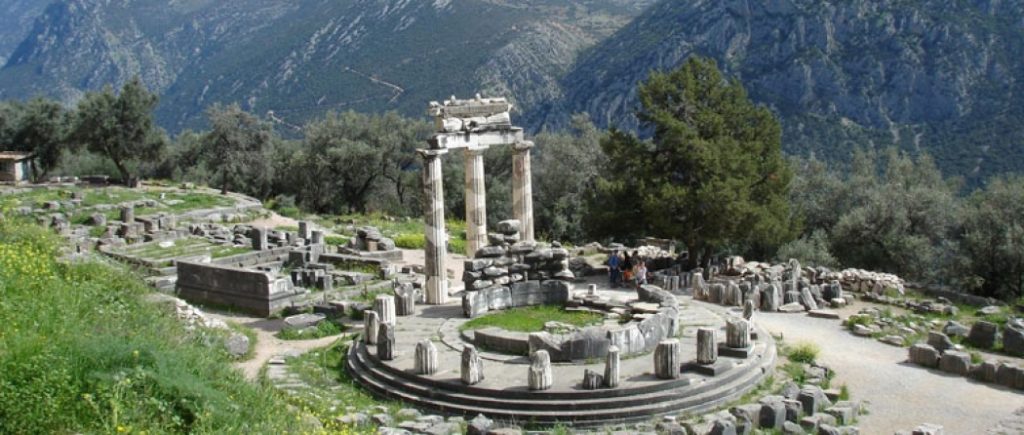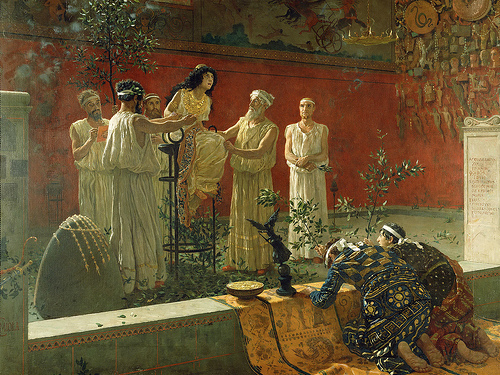
PHOTO: visitmeteora.travel.com
Almost everyone has heard of the famous Delphic Oracle. Whether it was from a school textbook, a documentary heralding the end of the world, or some other source, it’s not a phenomenon we’d forget. Humans have been fascinated with the Delphic Oracle ever since it was established in ancient times. The Greeks and Romans traveled from all corners of the known world to seek the Oracle’s wisdom. According to the Greeks, Delphi was the center of the world. Later, during the Renaissance, even Christians believed in the power of the Oracle to tell the truth. The Pythia was painted on the ceiling of the Sistine Chapel alongside Christian prophets like Moses because the Christians of the Renaissance believed that the Pythia, or Delphic Sybil, was a prophetess sent by God.
So, what was the deal with the Delphic Oracle, anyway? How did it get started? What was it for? Who was the Pythia, and was she high? That’s what we’re looking at today.
The Pantheon
![The omphalos stone at Delphi, where the center of the world was believed to be. [PHOTO: ancient-origins.net]](https://historythings.com/wp-content/uploads/2017/01/Sacred-Omphalos-Stone-delphi.jpg)
The omphalos stone at Delphi, where the center of the world was believed to be. [PHOTO: ancient-origins.net]
According to Greek mythology, it was from this spot at Delphi that Zeus released two eagles – one to the east, and one to the west. They circled the world and met back at Delphi, and so Delphi was named the center of the world.
The Pythia

PHOTO: flickr.com
Delphi was considered a major oracular shrine by the Hellenistic era. The oracle was a woman, a medium who was over fifty years old who lived separately from her husband and dressed like a maiden. She was dedicated to Apollo and was attended by priests and priestesses, and spent her life divining the future. By the 7th and 6th centuries BC, lawmakers, colonists, and founders of cults from all over the Hellenistic world sought Apollo’s advice as told by the Pythia, often demanding her to forecast about wars or politics.
In order to have a consultation with the Pythia, a person had to come to Delphi on the seventh day of the Delphic month bearing a gift for the Oracle, as well as a ritual cake and a sacrificial animal. Once the offering was received, the Pythia would bathe in a sacred spring and then enter the Temple of Apollo. Then, she would descend beneath the earth, sit on a sacred tripod (like a stool), chew on some laurel leaves (the sacred plant of Apollo), and start speaking nonsense. This nonsense would then be interpreted by some priests into pretty fantastic but ambiguous poetry.
Was it all hogwash, or was there something more at play in Delphi than meets the eye?
Beneath the Oracle
![Tourists in the tunnels beneath the Temple of Apollo, taking the same route ancient visitors would have had to take to seek an audience with the Oracle. [PHOTO: holylandphotos.org]](https://historythings.com/wp-content/uploads/2017/01/IMG_1095.jpg)
Tourists in the tunnels beneath the Temple of Apollo, taking the same route ancient visitors would have had to take to seek an audience with the Oracle. [PHOTO: holylandphotos.org]
But, on what, exactly?
The Delphic region has always been wracked with earthquakes. Recently, geologists have discovered that the Temple of Apollo runs directly over a faultline comprised of limestone. When tested, a team of researchers discovered that, like the Greek writers say, there was, in fact “vapors rising from the temple’s floors”: vapors made of ethylene, a sweet-smelling gas used as an anesthetic. In light doses, it produces euphoria. In fact, it’s the same gas found in paint thinner and glue. Of course, in large doses…it can be fatal.

PHOTO: biblicalarchaeology.org
By the time the Greek writers were recording the intricate goings-on of the Delphic Oracle, the temple had become much more than a simple religious site. Delphi is littered with extravagant gifts brought to the temple by those seeking an audience with the Pythia. Beneath the temple, the priests had dug an elaborate system of tunnels out of the limestone – meant to represent the underworld. They would have been dimly lit, and those wanting to seek the Oracle’s wisdom would have had to undergo a serious rite of passage to get to her by clambering through the narrow catacombs. Some researchers even believe that actors were paid to pop out at guests and scare them, similar to how a haunted house might be run today. By the time the visitors reached the elusive, swaying, gibberish-babbling figure on her tripod, they would have felt as if they’d entered another world. It was all part of an extremely lucrative, elaborate system…a system that didn’t always end well for the Pythia.
It’s speculated that the priests and the Pythia in charge of Delphi knew, somehow, that the gasses emitted from the faultline could be dangerous if inhaled too much. One Greek writer tells a story of how an important official came one day to seek the Pythia’s wisdom. However, something was wrong. The Pythia’s attendants told him it was the wrong time, that he had to come back later. He refused, and the priests urged the Pythia to give him an oracle now.
Forced into it, she descended into the earth to inhale the toxic fumes, and for whatever reason, (the writer blamed the gods, we blame an irregularity in the fumes), she inhaled too much of the gas, overdosed, and went into shock, raving, ranting, screaming…and eventually died.
In 480 BC, the Persians attacked the sanctuary at Delphi. In 279 BC, it was attacked again by the Gauls. The site changed hands a few more times, but hundreds of years later, in AD 393, Theodosius ordered all pagan sanctuaries closed, and this resulted in Delphi’s gradual decline. It was finally completely abandoned in the 7th century AD.
It was finally re-discovered by archaeologists, with the first modern excavations being done in 1880 by a team of French archaeologists. Today, the site has its own museum and tourists flock from all around the world to visit the empty chambers of the temple, much like they had thousands of years previously to seek the will of Apollo when the Oracle was at its height.
Was it all a complete sham for money? Did the priests and Pythia understand what they were doing? Or did they truly believe they were speaking for the gods? I guess we’ll never know.

